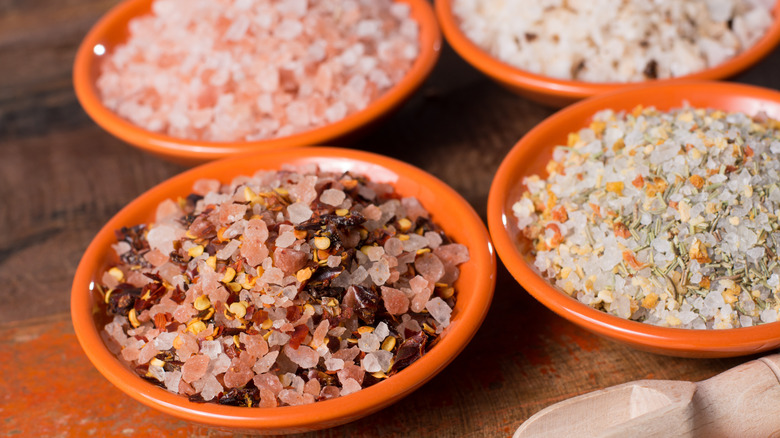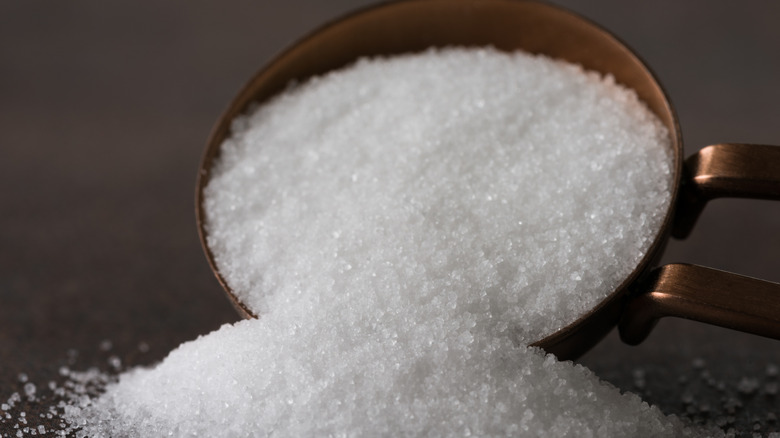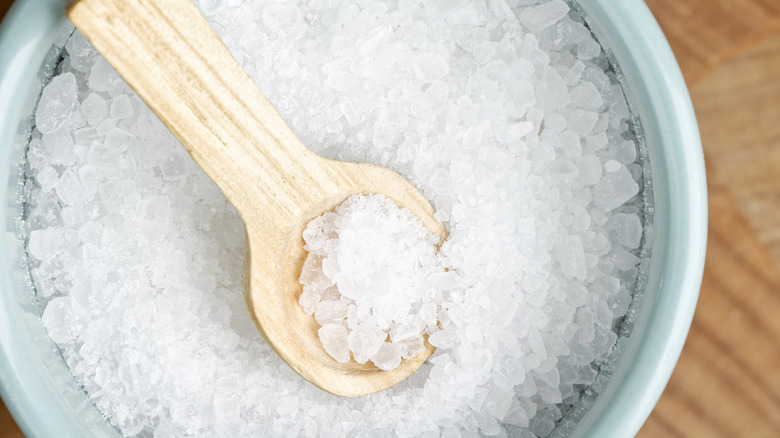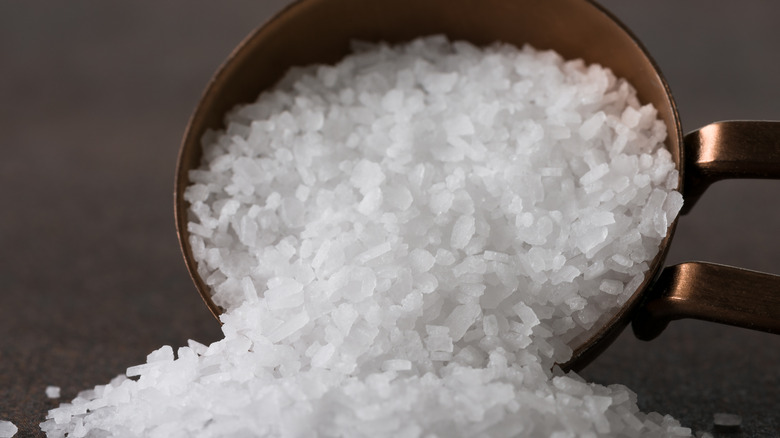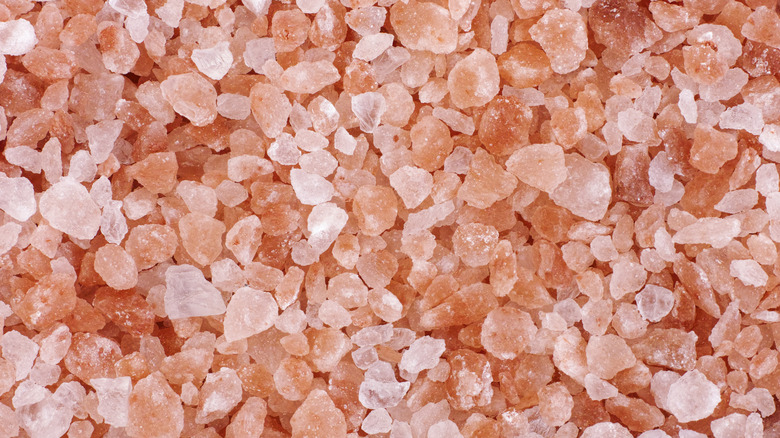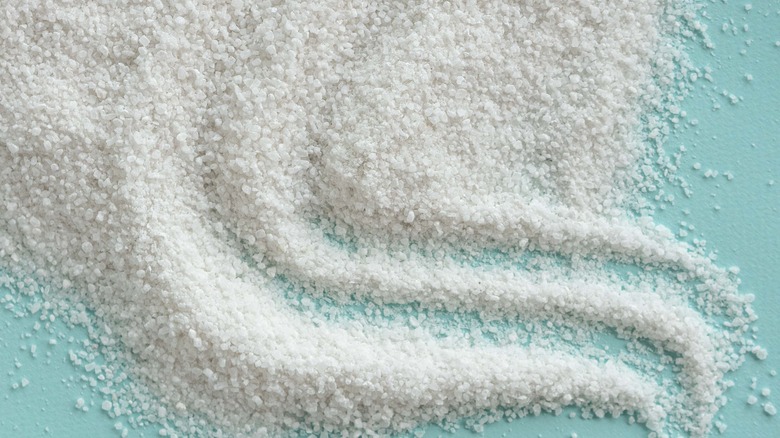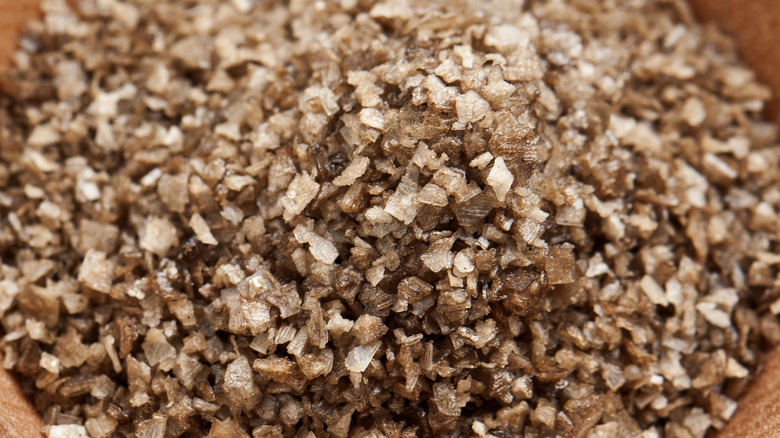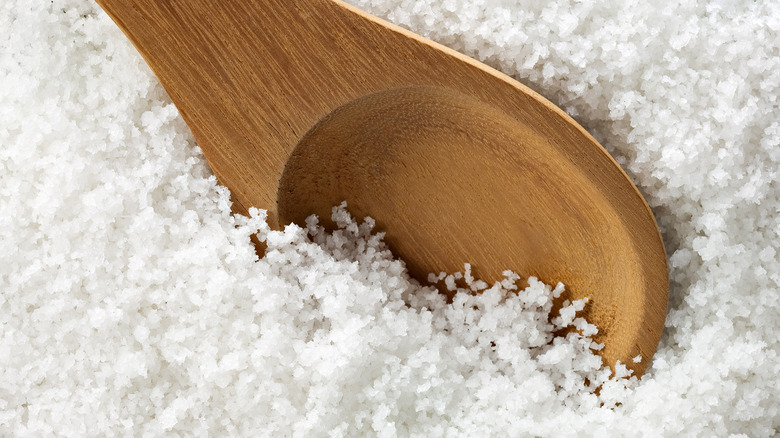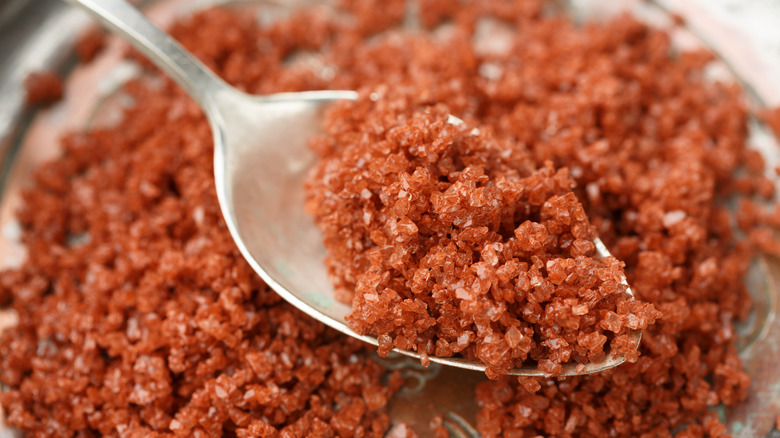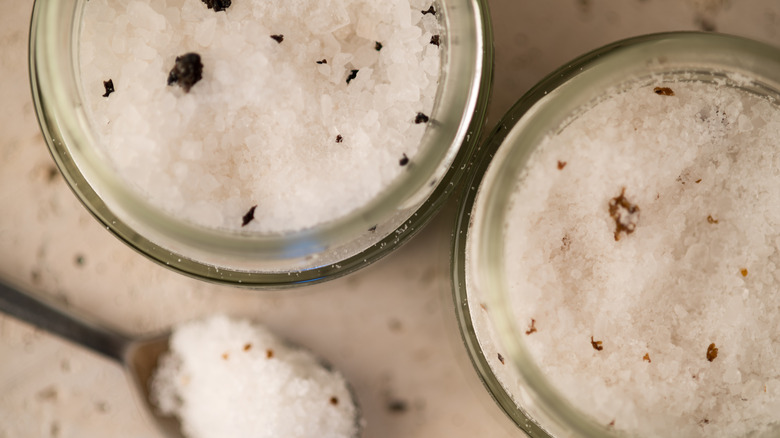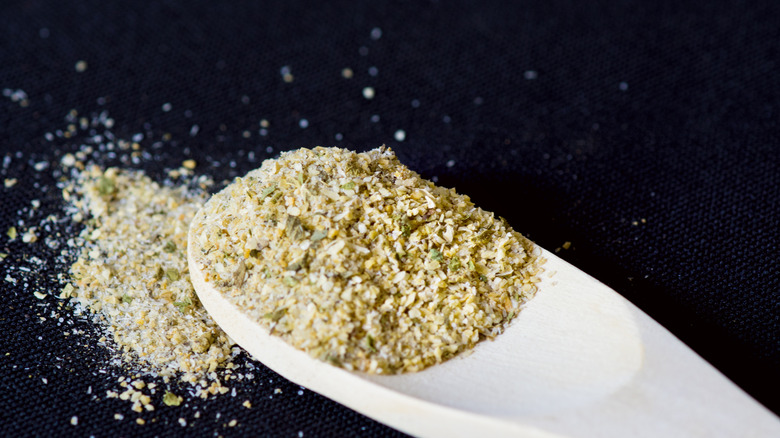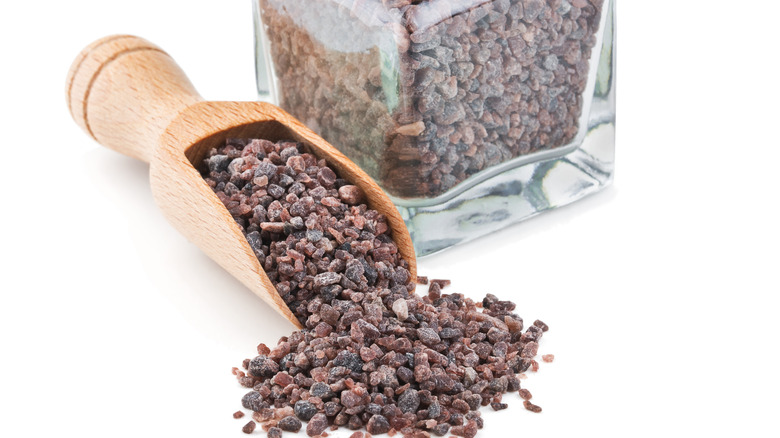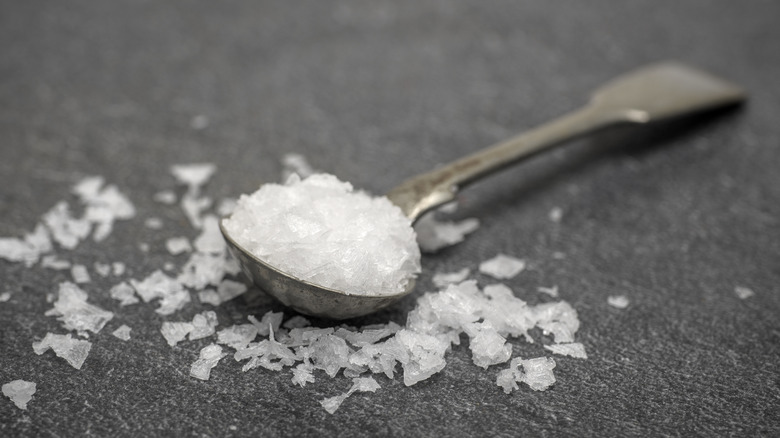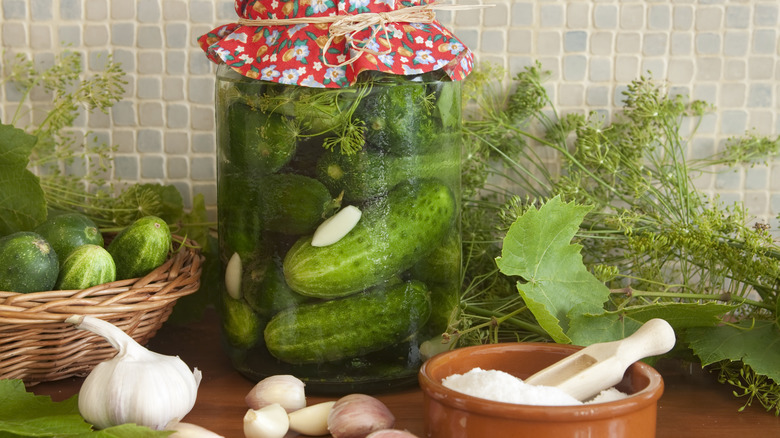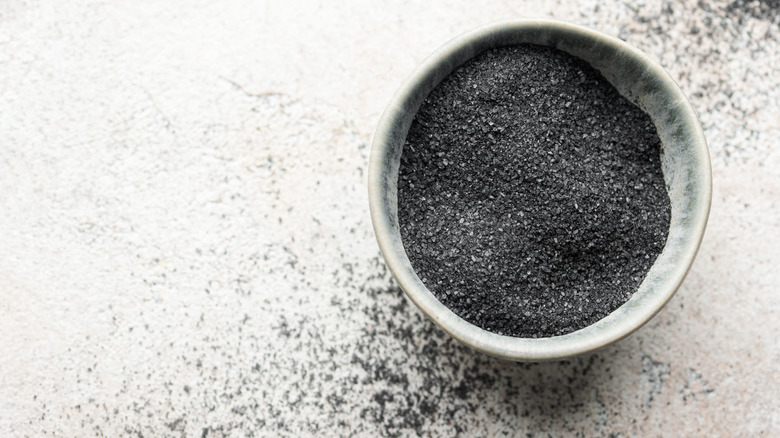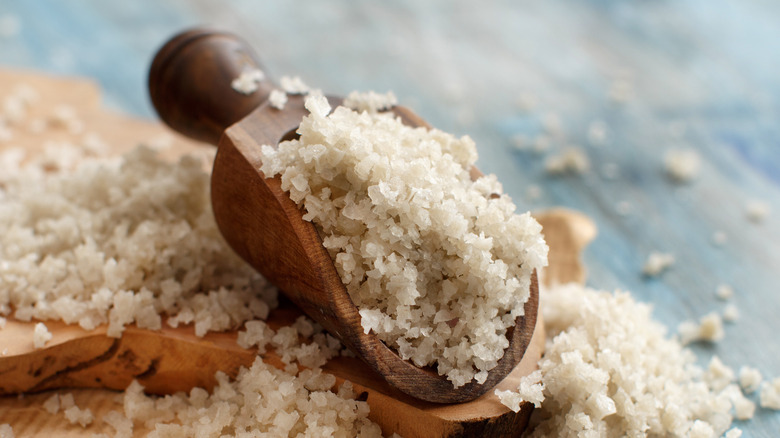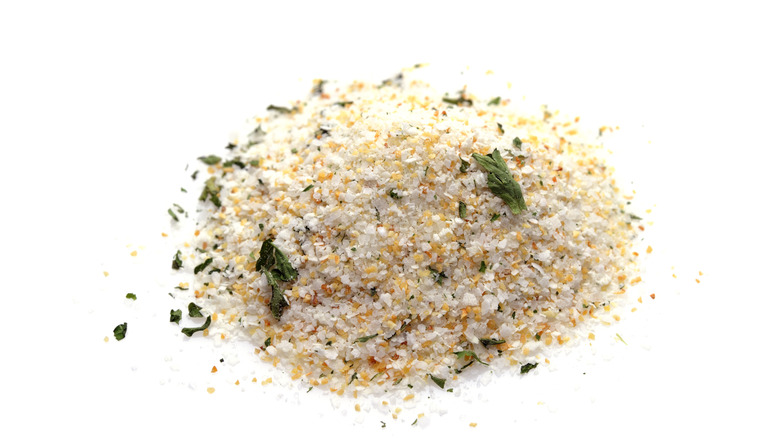16 Different Types Of Salt And How To Cook With Them
When it comes to cooking essentials, salt is one of the foundations that the culinary world is built around. Virtually all food we eat contains at least some salt naturally. The flavor of salt is one of the five primary tastes the human tongue is able to detect when eating. (The others are sweet, sour, bitter, and umami.) When used in moderation, adding salt to almost any food helps it to taste better — salt enhances the natural flavors of food, suppresses bitterness, balances flavor profiles, stimulates the taste buds, enhances aroma, and even makes certain foods more satisfying when we eat them. Salt does a lot when it comes to cooking and dining!
However, it's important to note that all salt is not the same. Sure, scientifically speaking, every variety of salt might have the same chemical blend of sodium and chloride. But, different "types" of salt also have different origins and sport different sizes, textures, and mineral compositions — all of which can give them a unique color or flavor that you won't find anywhere else. Because of these differences, that also means that chefs have developed specialized culinary applications where one form of salt performs better than all the others.
Here, we break down the 16 most common varieties of salt used in the culinary world, what each is best for, and how you can put them all to use. It's time to get salty!
1. Iodized or table salt
Iodized salt, or table salt as it's sometimes known, is the all-purpose workhorse of the salt world. It's not particularly fancy, unique, or special, but it tastes like salt and it gets the job done. If you're baking or cooking something that calls for a specific measurement, table salt is the way to go. Because it's refined from either mining salt deposits or evaporating seawater, table salt typically consists of fine, uniform crystals that dissolve easily, ensuring even distribution throughout any dish.
Salt with added iodine (iodized salt) first began appearing in grocery stores around 100 years ago, after the U.S. adopted the Swiss practice of adding sodium iodide or potassium iodide to table and cooking salt. At that time, the process was intended to help prevent the then-serious health condition of iodine deficiency, which could lead to problems with the thyroid and other potentially life-threatening illnesses. Today, it's possible to find table salt either with or without iodine — just check the label when you're buying groceries.
While you can use table salt for almost anything in the kitchen, it's best in a few specific instances — when you are following precise recipes, are dissolving salt in other liquids, or are sprinkling salt over popcorn and other snacks you eat by the handful. Table salt is also ideal for cocktails like the Vodka Salty Dog because its fine crystals adhere well to glass rims.
2. Rock salt
Rock salt is the culinary equivalent of the coarse salt you use in the winter to keep ice off your walk, except it has been rinsed and cleaned and is sold in a safe, food-grade quality. Rock salt's name comes from its rock-like appearance. These salt crystals are large, coarse, and irregularly shaped. They are much bulkier than almost any other type of salt you might encounter in the kitchen.
While rock salt's uses are far from as ubiquitous as those for something like table salt, it does have some applications where it truly shines. First and foremost among those uses, rock salt is often essential for the process of making homemade ice cream. You'll see many recipes that call for the addition of rock salt to the ice bath the ice cream is sitting in. It speeds up the cooling process and helps to create the necessary conditions that allow your ice cream mixture to freeze.
Similarly, rock salt is also sometimes combined with ice in a cooler or drink display to help quickly chill drinks — in particular, canned soda or beer — and keep them cold. You can also cook with rock salt: There's a centuries-old technique that involves completely coating a protein like fish or chicken in rock salt before baking it. This encrusting process can help to lock moisture into the fish while also infusing the protein with a subtle saltiness.
3. Kosher salt
In case you've ever found yourself wondering: No, kosher salt isn't actually kosher. There's no rabbi out there blessing bins of salt. The salt isn't Jewish, and there's nothing religious or region-specific about kosher salt at all. Instead, this super-coarse, granulated salt actually just gets its name from being a historically integral part of the meat koshering process. It was widely used to help draw out excess moisture, which is part of the process used to make meat kosher according to Jewish dietary laws.
More than that, there's a reason this salt has such a long history with meat. It's an ideal way to season steaks, roasts, or whole chickens — anything that might need a pinch of salt spread over the top before being placed in the oven or spread out on a hot grill. These large crystals quickly help to dissipate excess moisture on the surface of meat and can be very helpful for creating just the right charred, crispy crust on any meat you might be cooking.
Kosher salt is also ideal for brining chicken, pork, or seafood. Because the large crystals dissolve slowly in the saltwater solution, kosher salt can help to ensure your brined meat ends up extra juicy and tender. In addition, kosher salt is great for adding a crunch to pretzels or other baked goods.
4. Himalayan pink salt
While table salt, rock salt, and kosher salt all tend to be processed in some way before making it onto store shelves, Himalayan pink salt is all-natural and is never washed, bleached, or treated with chemicals. It also doesn't have anything added to help it flow or prevent it from caking — it simply is the way it was found in nature. Think of it as the difference between factory-raised and free-range chickens. That's not to say it's better than other salts, just that it's different.
These beautiful pink salt crystals tend to be most commonly mined from ancient salt deposits in the Himalayan mountains of Pakistan. The salt is typically harvested by hand to preserve its purity. Unlike processed salts, it also has trace levels of minerals like iron, potassium, and magnesium, which give it its characteristic pink hue. These minerals also give the salt a more mild, less sharp, and briny flavor. It's a subtle burst of salt flavor versus the full-powered punch you get from table salt.
Himalayan pink salt is typically considered a finishing salt. You can sprinkle these large salt granules over salads, grilled vegetables, and cooked meats whole, or grind them in a fancy salt mill for added kitchen flair. Himalayan pink salt is even good with dessert! Use it in salted caramels or rich chocolate-based treats like our favorite Salted Triple Chocolate Brownies. Yum!
5. Fine sea salt
As you might have guessed, sea salt originates from the ocean. Sea water is collected in shallow pools and allowed to evaporate, leaving behind the wonderful salt crystals we call sea salt. It's a process that humans have been carrying out for centuries and is a beloved tradition in many cultures.
Compared to table salt, sea salt is only minimally processed, so it's much closer to being completely natural. Like Himalayan pink salt, sea salt also typically contains a mix of flavor-boosting minerals including iron, potassium, and calcium. Sea salt crystals also tend to be slightly larger and have a coarser texture compared to table salt. This larger size can make the salt seem a bit more mild, adding a pleasant crunch and bursts of flavor instead of the overall saltiness that you might get from table salt.
Sea salt is another great option as a finishing salt that is sprinkled over dishes just before serving. It's also perfect for use in brines and marinades, where it can help to add flavor to meats and tenderize them before cooking. If you like to cook proteins with a salt rub, it's a perfect option paired with some of your favorite herbs and spices. Finally, sea salt is ideal for use when making pasta. Just add a generous pinch to your water as you bring it to a boil and the pasta will absorb the salt while it cooks.
6. Smoked salt
Modern grocery stores are filled with all kinds of flavored salts — you might see lavender salt, citrus salt, or even vanilla salt. But, none of these salts would exist without the original flavored salt — smoked salt. No one really knows when smoked salt originated; we just know it has been a part of human history for thousands of years. Back then, people had two ways to preserve meat: They could smoke it, or they could preserve it with salt. At some point, the two merged and some lucky individuals realized that salt that had been exposed to smoke was pretty tasty, too. Soon, people weren't just smoking salt as an accidental part of preserving meat — they were doing it on purpose to give their salt the incredible, rich, smokey flavor of oak, hickory, applewood, or mesquite.
Any kind of salt can be smoked — it just has to be held over smoldering wood chips or exposed to the smoke from burning materials long enough to pick up that rich, smoky flavor. Smoked salt is of course excellent when paired with grilled or smoked dishes like barbecued ribs, grilled fish, or roasted vegetables, where it can add an extra layer of smokiness. It's also great for boosting the flavor of soups and stews. For an incredible surprise, try adding a dash of smoked salt to mac and cheese before serving, or sprinkle a few flakes on roasted Brussels sprouts for a mouth-watering side.
7. French fleur de sel
Fleur de sel is perhaps the highest quality salt you can buy. Produced in France (the name translates as "flower of salt"), the salt comes from small ponds where seawater evaporates and forms a thin, delicate crust on the water's surface. Laborers use wooden rakes to collect the salt by hand — a process that is quite costly and tedious. But, it's worth it! Fleur de sel is so fragile and delicate that its crystals have been compared to fresh snowflakes. It's typically white or pale gray and has a subtle, less salty flavor with hints of different minerals and an almost sweet taste according to some experts. The salt is so delicate that the sea breeze where it is formed is said to impact its flavor, making salt from different regions unique and special — they each have a one-of-a-kind taste.
While Fleur de sel can be used on salads, grilled meats, roasted vegetables, and seafood, it shines in other applications. Many bakers love to use a gentle dusting of fleur de sel on chocolates and caramels to enhance the richness and sweetness of the treats. Fleur de sel is also said to be the perfect salt to add to fresh fruits such as watermelon, strawberries, or mangoes to enhance their natural flavor. For a taste of France right in your own kitchen, add a small dusting of fleur de sel to warm, buttered toast or a fresh croissant. Easy and delicious!
8. Red Hawaiian salt
A sort of culinary cousin to Himalayan pink salt, red Hawaiian salt is another all-natural form of salt, this time originating in the islands of Hawaii. The salt gets its unique, reddish-brown color from the land it is found in, in this case the iron-rich volcanic clay found throughout the state's eight beautiful islands. That clay is called "Alaea" by indigenous Hawaiians, and the salt itself sometimes carries that name, as well — Alaea salt.
Besides impacting the color of the salt, the iron in Alaea clay also influences its flavor, creating a mild and earthy taste with hints of sweetness and nuttiness. In addition to being a main component in many traditional Hawaiian dishes such as roasted pigs and poke, red Hawaiian salt has a long history of ceremonial usage and is even believed to have healing properties.
Red Hawaiian salt is wonderful sprinkled over fish, shrimp, or other seafood before you place them on the grill. It's also perfect in salt rubs on steaks or other roasted meats. All vegetables work well with red Hawaiian salt, but for a unique, tropical treat, try it with some freshly sliced pineapple. Just mix a bit of the salt with water and stir until dissolved. Then, dip your pineapple in the red salt water mixture, shake, and eat fresh. The salt will amplify the sweetness of the pineapple and may even eliminate that tingling in the mouth some people get when eating fresh pineapple.
9. Truffle salt
Truffle salt is a luxury finishing salt designed to add to food right before serving — it's not a salt you cook with. Packed with the rich, umami goodness of truffles, it's an ideal way to add nuttiness and earthiness to dishes ranging between scrambled eggs, popcorn, french fries, elaborate pasta meals, and rustic, roasted veggies.
Truffle salt can be created in two ways. For an infused truffle salt, you need real truffles. The decadent, fragrant fungus is placed in a sealed container of salt. Over time, the truffle releases its beautiful flavor and aroma and they are absorbed by the crystals, creating a truffle-infused salt. Because truffles can be quite expensive, truffle-infused salts also tend to be pricey. For a more affordable alternative, consider truffle-flavored salt, which is salt that has been flavored with truffle oil or artificial truffle flavor. Surprisingly, infused and flavored salts can actually taste quite similar.
Making your own truffle-flavored salt at home is easy. Just take a cup of coarse sea salt or kosher salt and pour it into a bowl. Next, drizzle in a small amount of truffle oil and stir. The intensity of your salt is up to you. The more truffle oil you use, the more flavor the salt will carry. When done mixing, spread the truffle oil–coated salt crystals onto a baking sheet lined with parchment paper, let dry overnight, and then store in a dry, glass jar.
10. Garlic salt
Garlic salt is neither an infused salt nor a flavored salt. Instead, it's a salt blend — a literal mixture of granulated garlic powder with some type of salt (usually table salt). The two are mixed in varying ratios, depending on the manufacturer, adding both the flavors of salt and garlic to a dish at the same time while cooking. The idea is intended to help make cooking quicker and easier — you can add two flavorings at once without having to measure or combine individual ingredients. The beauty of garlic salt is that it does what it was intended to do: It lets you add garlic and salt to whatever you are cooking in one single shot. However, because you can't control the amount of garlic and salt you are adding, the flavors can also seem unbalanced at times
There are a number of different salt blends in existence besides garlic salt — seasoning salt, lemon pepper salt, celery salt, Italian seasoning salt, and more. All of them are created by adding some type of herb or spice to table salt. If you like the blend, these salts can be a wonderful addition to your kitchen. If you find them overpowering in some way, you may be better off creating your own salt blend instead of buying one. Just mix table salt and a favorite seasoning to your specific taste, pour the mixture into a spice shaker, and use as needed!
11. Kala namak or black salt
Black salt, or kala namak, is a type of salt commonly used in many South Asian and Indian dishes. It's especially popular in India, Nepal, and Pakistan. Somewhere between a natural salt and an infused salt, kala namak is harvested from deep mines that are rich in minerals including sulfur, which gives the salt a distinctive "egg-like" taste.
While kala namak can be used in all the same ways as regular salt, it is also widely used by vegans and individuals following a plant-based diet who want to recreate the flavor of eggs in their meals. It can be added to tofu scrambles, chickpea flour omelets, vegan egg salads, and vegan mayo. Kala namak is also commonly used in a yogurt-based Indian condiment called raita, as well as spicy chutneys, and even a number of different types of brined pickles.
One easy way to experience kala namak if you haven't had it before is by making some simple spiced nuts. Just mix together 2 cups of unsalted nuts, 1 tablespoon of oil, 1 teaspoon of kala namak, and your choice of added cumin, coriander, cayenne pepper, cinnamon, and (optionally) a drizzle of honey. Spread your salty nut mixture onto a baking sheet and bake at 325 degrees Fahrenheit until lightly toasted. Let cool, and then dig in!
12. Flake salt
Flake salt is commonly used in restaurant settings to finish dishes, due to its attractive shape. It has the same origin as regular sea salt but the method of collecting the salt differs. In hot climates, seawater is evaporated by the heat of the sun, allowing the flaky crystals to form naturally. In cooler climates, such as Maldon in Essex, where the world-famous Maldon flake salt is from, they have to help the process along by applying heat. The seawater is evaporated in shallow pans to allow the crystals to form and be harvested by hand.
The large surface area and irregular shape of these salt crystals are what make them so desirable. They have a very crisp, salty flavor with a delicate texture, and they stick well to food, meaning they can be sprinkled over a dish just before serving for the perfect presentation. As the diner takes a bite, their taste buds will be rewarded with a subtle crunch and slight hit of saltiness that will lift the dish without overwhelming it.
Although flake salt is perfect as a finishing salt, it can also be used during cooking as its delicate texture allows you to easily grind it into a finer powder using your fingers. It dissolves quickly, meaning it can impart an even flavor to dishes. Flake salt is a great seasoning to keep in your pantry, allowing you to add the distinctive flavor of sea salt to your dishes with a bit of finesse.
13. Pickling salt
If you're a fan of pickles, you may have considered pickling your own vegetables at some point, but perhaps were put off by the seemingly complex process. In truth, pickling at home is fairly straightforward as long as you choose the correct salt: the aptly named pickling salt.
The reason salt is crucial when pickling vegetables is that it reduces the chances of dangerous bacteria growing during the fermentation process. Pickling salt is a sodium chloride salt that has none of the additives that you would find in other salts, like iodine or anti-caking agents. Salt will naturally clump together when it is exposed to moisture — the reason restaurants often add rice to their salt shakers — so many commercial salts contain anti-caking agents. The lack of additives means the pickling liquid will remain clear and bright. If you're struggling to find pickling salt, table salt can be used, but your mixture will turn dark and cloudy, losing its visual appeal.
Technically, pickling salt can be used to season food, but the main reason you would buy it is to pickle your own vegetables. This can be done in as little as 20 minutes, however, the longer you leave the veggies in the pickling liquid, the better the result will be. Whether you want to make the classic dill pickled cucumber or be more creative with pickled garlic, using pickling salt instead of regular salt will help make top-quality pickles that look and taste great.
14. Black lava salt
If you want to make a statement with the presentation of your dishes, using black lava salt is a good way to do so. This unusual salt, also known as Hawaiian black salt, is a finishing salt made from sea salt mixed with activated charcoal. Hawaiian black lava salt does not contain actual lava, but there is activated charcoal mixed with it that has a number of potential health benefits, including helping the body to remove toxins.
As well as the most common Hawaiian version, other black lava salts from regions such as Iceland and Cyprus are available and each one has its own distinctive flavor. Lava salt in general has a subtle flavor with smoky notes, which can add a unique twist to your dishes. And, of course, it offers tremendous visual appeal. Sprinkling a few flakes on top of a light-colored dish will create quite a striking contrast and take your presentation up a notch.
15. Sel gris or gray salt
Sel gris, also known as gray salt, may not have the fame of the much trendier Himalayan salt, but it deserves to be acknowledged for its rich mineral content and complex flavors. Originating in the Brittany and Pays de Loire regions of France, Sel gris gets its distinctive gray color from the clay in the salt ponds where it is harvested. It can be used as both a cooking salt and a finishing salt, benefiting from both its unusual color and depth of flavor. Sel gris contains numerous minerals, including magnesium and potassium, which, along with its slightly lower sodium content, can make it a better option than table salt.
This gray salt has an unusual texture; it retains more moisture than regular sea salt, so it feels moist to the touch. Its large crystals mean it dissolves more slowly in food, so it is a great salt to add to foods as they cook, imparting its unique flavor to the dish over time. Adding sel gris to your collection of salts means you can enhance your dishes with its rich mineral flavor, or use it as a finishing salt for a crunchy delight.
16. Seasoned salt
When you're adding seasoning to your food, why settle for salt on its own? Though many of us think of seasoning as being simply salt and pepper, there are many other ways to enhance your food using herbs and spices. Seasoned salt brilliantly combines salt with one or more herbs and spices to create the ultimate flavor booster. If you're looking to buy seasoned salts, there are many flavors on offer. From rosemary or lemon salt for your Mediterranean dishes to paprika or chili salt when you need a bit of heat, it's worthwhile to stock your pantry with a few different options to suit a variety of dishes.
Seasoned salts can be used during cooking to add depth of flavor to your dishes, or can be added at the end to fries or eggs for a burst of flavor. Garlic salt is a brilliant salt to season your steak with, while a cajun-style salt will pair perfectly with fish. You could also use paprika salt to make your own salt pork as a flavorsome replacement for bacon.
Just remember that it is still salt, and needs to be used sparingly for the benefit of your health and your taste buds! The great thing about seasoned salt is it may, over time, lead to you consuming less sodium since the added herbs and spices will lift the dish without the need for as much salt.

